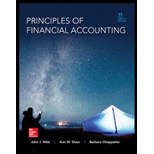
Concept explainers
a.
Record the April 30 adjusting entry and subsequent payment entry in May for the payment legal service expenses.
a.
Explanation of Solution
Record the adjusting entry:
| Date | Accounts title and explanation | Post Ref. |
Debit ($) |
Credit ($) |
| April 30 | Legal service expense | 3,500 | ||
| Legal service payable | 3,500 | |||
| (To record the adjusting entry for accrued legal fees) |
Table (1)
- Legal service expense is an expense account and it is increased. Therefore, debit legal service expense with $3,500.
- Legal service payable is a liability account and it is increased. Therefore, credit legal service payable with $3,500.
Subsequent payment entry:
| Date | Accounts title and explanation | Post Ref. |
Debit ($) |
Credit ($) |
| May 12 | Legal service payable | 3,500 | ||
| Cash | 3,500 | |||
| (To record the payment of accrued legal fees) |
Table (2)
- Legal service payable is a liability account and it is decreased. Therefore, debit legal service payable with $3,500.
- Cash is an asset account and it is decreased. Therefore, credit cash with $3,500.
b.
Record the April 30 adjusting entry and subsequent payment entry in May for the payment Interest expense.
b.
Explanation of Solution
Adjusting entries: Adjusting entries are those entries which are recorded at the end of the year, to update the income statement accounts (revenue and expenses) and balance sheet accounts (assets, liabilities, and stockholders’ equity) to maintain the records according to accrual basis principle.
Record the adjusting entry:
| Date | Accounts title and explanation | Post Ref. |
Debit ($) |
Credit ($) |
| April 30 | Interest expense | 3,000 | ||
| Interest payable | 3,000 | |||
| (To record the adjusting entry for accrued interest expense) |
Table (3)
- Interest expense is an expense account and it is increased. Therefore, debit interest expense with $3,500.
- Interest payable is a liability account and it is increased. Therefore, credit interest payable with $3,500.
Working note:
Calculate the amount of interest expense:
Subsequent payment entry:
| Date | Accounts title and explanation | Post Ref. |
Debit ($) |
Credit ($) |
| May 20 | Interest payable | 3,000 | ||
| Interest expense | 6,000 | |||
| Cash | 9,000 | |||
| (To record the payment of accrued interest expense) |
Table (4)
- Interest payable is a liability account and it is decreased. Therefore, debit interest payable with $3,000.
- Interest expense is an expense account and it is increased. Therefore, debit insurance expense with $6,000.
- Cash is an asset account and it is decreased. Therefore, credit cash with $9,000.
Working note:
Calculate the amount of interest expense:
c.
Record the April 30 adjusting entry and subsequent payment entry in May for the payment salaries expense.
c.
Explanation of Solution
Adjusting entries: Adjusting entries are those entries which are recorded at the end of the year, to update the income statement accounts (revenue and expenses) and balance sheet accounts (assets, liabilities, and stockholders’ equity) to maintain the records according to accrual basis principle.
Record the adjusting entry:
| Date | Accounts title and explanation | Post Ref. |
Debit ($) |
Credit ($) |
| April 30 | Salaries expense | 4,000 | ||
| Salaries payable | 4,000 | |||
| (To record the adjusting entry for accrued salaries expense) |
Table (5)
- Salaries expense is an expense account and it is increased. Therefore, debit salaries expense with $4,000.
- Salaries payable is a liability account and it is increased. Therefore, credit salaries payable with $4,000.
Working note:
Calculate the amount of accrued salaries expense:
Subsequent payment entry:
| Date | Accounts title and explanation | Post Ref. |
Debit ($) |
Credit ($) |
| May 3 | Salaries payable | 4,000 | ||
| Salaries expense | 6,000 | |||
| Cash | 10,000 | |||
| (To record the payment of accrued salaries expense) |
Table (6)
- Salaries payable is a liability account and it is decreased. Therefore, debit salaries payable with $4,000.
- Salaries expense is an expense account and it is increased. Therefore, debit salaries expense with $6,000.
- Cash is an asset account and it is decreased. Therefore, credit cash with $10,000.
Working note:
Calculate the amount of accrued salaries expense:
Want to see more full solutions like this?
Chapter 3 Solutions
Principles of Financial Accounting.
- Please explain the solution to this general accounting problem using the correct accounting principles.arrow_forwardCan you solve this general accounting problem using appropriate accounting principles?arrow_forwardI need help solving this general accounting question with the proper methodology.arrow_forward
- Please provide the answer to this general accounting question using the right approach.arrow_forwardPlease help me solve this general accounting question using the right accounting principles.arrow_forwardCan you solve this financial accounting question with accurate accounting calculations?arrow_forward

 AccountingAccountingISBN:9781337272094Author:WARREN, Carl S., Reeve, James M., Duchac, Jonathan E.Publisher:Cengage Learning,
AccountingAccountingISBN:9781337272094Author:WARREN, Carl S., Reeve, James M., Duchac, Jonathan E.Publisher:Cengage Learning, Accounting Information SystemsAccountingISBN:9781337619202Author:Hall, James A.Publisher:Cengage Learning,
Accounting Information SystemsAccountingISBN:9781337619202Author:Hall, James A.Publisher:Cengage Learning, Horngren's Cost Accounting: A Managerial Emphasis...AccountingISBN:9780134475585Author:Srikant M. Datar, Madhav V. RajanPublisher:PEARSON
Horngren's Cost Accounting: A Managerial Emphasis...AccountingISBN:9780134475585Author:Srikant M. Datar, Madhav V. RajanPublisher:PEARSON Intermediate AccountingAccountingISBN:9781259722660Author:J. David Spiceland, Mark W. Nelson, Wayne M ThomasPublisher:McGraw-Hill Education
Intermediate AccountingAccountingISBN:9781259722660Author:J. David Spiceland, Mark W. Nelson, Wayne M ThomasPublisher:McGraw-Hill Education Financial and Managerial AccountingAccountingISBN:9781259726705Author:John J Wild, Ken W. Shaw, Barbara Chiappetta Fundamental Accounting PrinciplesPublisher:McGraw-Hill Education
Financial and Managerial AccountingAccountingISBN:9781259726705Author:John J Wild, Ken W. Shaw, Barbara Chiappetta Fundamental Accounting PrinciplesPublisher:McGraw-Hill Education





